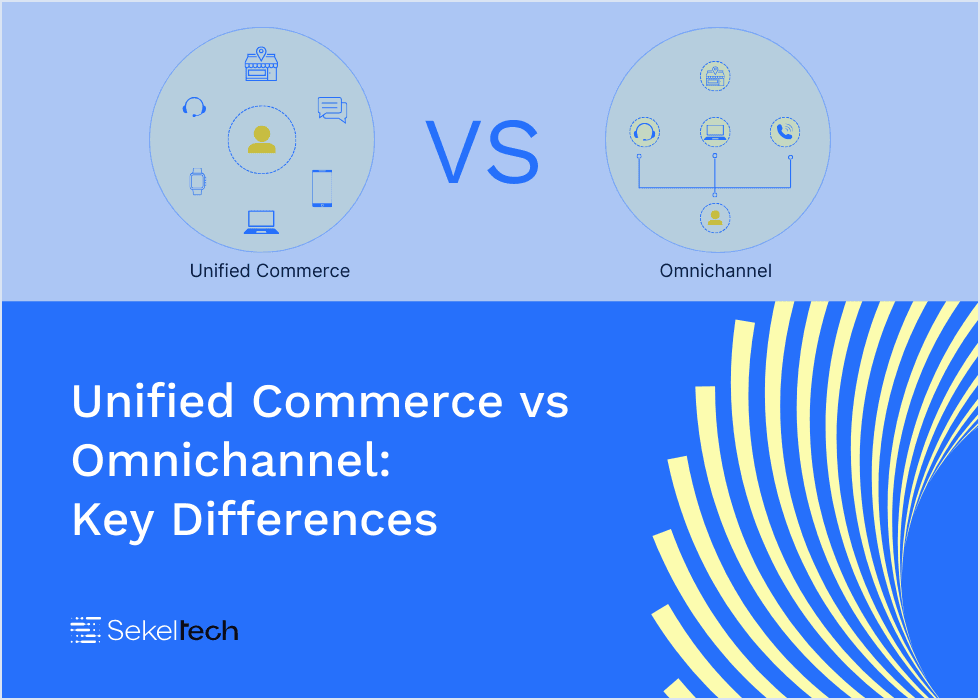Omni Channel
Unified Commerce vs Omnichannel: Key Differences in 2025
Mon, 20 Jan 2025 10:08:29 GMT
Speak to our Hyperlocal Expert

Omnichannel unified commerce combines seamless customer experiences across all channels with a fully integrated backend system. It ensures real-time data synchronization, streamlines operations, and delivers personalized interactions, enhancing both efficiency and engagement.
The retail landscape in 2025 is transforming rapidly, driven by technological innovation and rising consumer expectations. As businesses aim to provide seamless shopping experiences, the debate between unified commerce vs omnichannel strategies has become more relevant than ever.
While omnichannel commerce focuses on integrating multiple sales channels for consistency, unified commerce centralizes operations into a single platform for efficiency and scalability. Understanding these differences is crucial for businesses to choose the right approach for growth.
This blog delves into the key distinctions, benefits, and trends in omnichannel unified commerce, helping you navigate the future of retail with confidence.
What is Omnichannel Commerce?

Omni channel commerce integrates multiple sales and communication channels to offer a seamless and consistent shopping experience. It ensures that customers receive a unified experience across online, in-store, and mobile platforms.
Core Features of Omnichannel
1. Channel Integration
Combines physical stores, online platforms, mobile apps, and social media for a unified experience.
2. Data Synchronization
Ensures real-time updates across all channels.
3. Customer-Centric Design
Offers convenience, like click-and-collect and flexible returns.
Successful Omnichannel Examples in 2025
1. A fashion retailer syncing in-store inventory with mobile app features.
2. Grocery stores provide online ordering with curbside pickup.
3. Electronics brands integrate chat support with in-store service.
Key Benefits of Omnichannel Commerce
1. Seamless Experience
Consistent transitions between channels.
2. Multiple Touchpoints
Increased opportunities for engagement.
3. Improved Engagement
Personalized marketing enhances customer loyalty.
By adopting omnichannel unified commerce, businesses can enhance customer experiences and stay competitive in 2025.
Read Also - Boost Your Sales: Top 15 Omni Channel Commerce Platforms
What is Unified Commerce?

Unified Commerce connects all business functions and customer touchpoints via a centralized system. Unlike omnichannel, which ensures consistent experiences across channels, unified commerce integrates everything—from customer interactions to inventory management—into one platform, providing real-time data synchronization for a complete view of operations and customer behavior.
The key difference between omnichannel and unified commerce is that unified commerce integrates backend processes (sales, inventory, customer service) into a single system, ensuring accuracy and efficiency.
Key Features of Unified Commerce
1. Centralized System
Manages all customer data, inventory, and sales in one platform.
2. Real-Time Synchronization
Ensures up-to-date data across all channels.
3. 360-Degree Customer View
Offers insights into customer preferences and behaviors across touchpoints.
Examples of Brands Using Unified Commerce
1. Nike
Integrates online, mobile, and in-store experiences into one system for personalized shopping.
2. Walmart
Synchronizes online and in-store data for real-time inventory and customer management.
Unified commerce streamlines operations and delivers more personalized, efficient customer experiences.
Key Differences Between Unified Commerce and Omnichannel
Feature | Unified Commerce | Omnichannel |
System Integration | Centralized system for all functions (sales, inventory, customer service) | Separate systems for each channel, integrated loosely |
Data Synchronization | Real-time synchronization of all data across channels | Data may not be synchronized in real-time across channels |
Customer Experience | Consistent experience with a 360-degree customer view | Consistent experience but without full backend integration |
Technology Focus | Complete integration of all business operations into one platform | Focus on integrating customer-facing channels like online, mobile, and in-store |
Flexibility | Highly flexible with seamless data sharing across channels | Focus on customer interactions, but channels may operate independently |
Examples | Nike, Walmart (integrates all touchpoints and operations) | Starbucks, Target (integrate customer-facing touchpoints) |
In summary, Unified Commerce integrates all aspects of business operations into one system, whereas Omnichannel focuses primarily on ensuring a seamless customer experience across various touchpoints.
How Omnichannel Strategies Improve Customer Experience and Sales
Omnichannel strategies play a crucial role in enhancing customer experience and driving sales by delivering seamless interactions across online-offline, and mobile channels. Unlike in a simple omnichannel vs unified commerce comparison, omnichannel focuses on providing flexibility for customers to engage with brands through their preferred touchpoints, fostering satisfaction and loyalty.
Features such as click-and-collect services and personalized marketing bridge the gap between digital and physical platforms. For instance, a customer can browse products online, receive tailored recommendations via email, and complete the purchase in-store—all part of a consistent journey.
When considering unified commerce vs omnichannel, omnichannel strategies emphasize customer convenience, leading to increased sales opportunities by ensuring that customers' needs are met across various channels. By adopting omnichannel unified commerce strategies, businesses not only improve customer relationships but also position themselves for sustainable growth in a competitive market.
Gain more insights with this short and informative video."How Can Your Store Drive More Sales Through Omni Commerce Integration"
How Unified Commerce Transforms Business Operations and Customer Experience
Unified commerce connects all aspects of business operations—sales, inventory, customer data, and service—into a single, centralized system, making it a step ahead in the unified commerce vs omnichannel debate. While omnichannel unified commerce focuses on enhancing customer experiences across channels, unified commerce integrates backend operations for seamless functionality.
With real-time inventory management, businesses can provide accurate stock information, reducing missed sales opportunities. Unlike omnichannel, which may operate on separate systems, unified commerce ensures centralized data, enabling personalized customer interactions and customized recommendations. For example, customers can check online availability and make purchases in-store without disruptions—a significant edge in the omnichannel vs unified commerce conversation.
The benefits extend to operational efficiency, as businesses can manage resources effectively, reduce costs, and optimize decision-making. Customers enjoy consistent shopping experiences and tailored services, fostering loyalty and satisfaction.
Unified commerce transforms businesses by merging operational excellence with superior customer experiences, setting a new standard in modern retail strategies
Key Challenges of Omnichannel and Unified Commerce
Challenges in Omnichannel
1. Managing Disparate Systems
Omni channel strategies often rely on multiple platforms to manage customer touchpoints like online stores, physical locations, and social media. These disconnected systems can lead to data silos, inefficiencies, and operational challenges.
2. Maintaining Consistency Across Channels
Ensuring a seamless customer experience across various channels can be difficult. For instance, discrepancies in pricing, inventory, or promotions between online and offline channels can create confusion and negatively impact customer satisfaction.
Challenges in Unified Commerce
1. High Implementation Costs
Adopting a unified commerce platform often requires significant investment in technology and infrastructure. This includes setting up centralized systems and training teams, which can be expensive for small and mid-sized businesses.
2. Need for Advanced Technology and Expertise
Unified commerce depends on real-time data synchronization, centralized platforms, and advanced analytics. Businesses may struggle to find the technical expertise or resources needed to implement and maintain such systems effectively.
Both omnichannel and unified commerce present unique challenges, but addressing these can pave the way for enhanced customer experiences and operational efficiency. Businesses must weigh the benefits against the costs and invest in strategies that align with their growth goals.
The Future of Omnichannel vs Unified Commerce in 2025 and Beyond
1. Emerging Trends
In 2025, both omnichannel and unified commerce will harness AI, automation, and real-time personalization to enhance customer experiences and operational efficiency.
2. AI and Automation
Omnichannel will use AI for personalized customer interactions across touchpoints, while unified commerce will leverage AI for real-time inventory management and customer service, streamlining both front-end and back-end processes.
3. Cloud Computing Impact
Cloud computing will enable real-time data synchronization across channels, allowing businesses to keep customer and inventory data consistent, improving both engagement and decision-making.
4. Real-Time Personalization
Personalized experiences will be enhanced with real-time data, enabling omnichannel strategies to deliver targeted messages. Unified commerce will provide even smoother transitions, offering personalized experiences across digital and physical touchpoints.
5. Balancing Engagement with Efficiency
As technology evolves, businesses will need to balance engagement and operational efficiency. Both omnichannel and unified commerce will rely on advanced technologies to meet customer expectations while optimizing operations.
The future of both models will center on using AI, cloud computing, and real-time personalization to improve customer experiences, streamline processes, and boost business performance in 2025 and beyond.
Discover valuable insights with this enlightening article Why D2C businesses need to focus on unified commerce from the Times of India, offering a wealth of information to expand your understanding.
Frequently Asked Questions (FAQs)
1. What is Unified CRM?
A unified CRM (Customer Relationship Management) system integrates all customer interactions and data into a single platform, providing businesses with a 360-degree view of customer behavior. It helps improve customer engagement and streamline communication across all touchpoints.
2. What is a Unified Service Desk?
A unified service desk consolidates multiple customer service tools and channels into one interface. This enables support teams to deliver consistent, efficient service while accessing a centralized system for tracking and resolving issues across various platforms.
3. Why is Unified Commerce Important?
Unified commerce is crucial because it connects all aspects of a business—sales, inventory, customer data, and operations—into one integrated system. This enables real-time insights, improved operational efficiency, and personalized customer experiences across multiple channels.
4. What is Omnichannel Marketing?
Omnichannel marketing is a strategy that ensures a seamless customer experience across various platforms, such as online, in-store, social media, and mobile apps. It focuses on integrating all communication channels to create a unified brand experience.
5. What are the 4 Pillars of Omnichannel?
The four pillars of omnichannel marketing are consistency, personalization, accessibility, and integration. These principles help ensure that customers receive a unified and relevant experience, no matter which channel they use to interact with a brand.
Conclusion
In conclusion, unified commerce and omnichannel enhance customer experiences in different ways. Omnichannel focuses on seamless customer interaction across multiple touchpoints, while unified commerce integrates all business operations into a single system for real-time data synchronization. Although omnichannel remains essential for consistency, unified commerce is becoming increasingly important for businesses aiming to streamline operations and offer personalized experiences at scale. With evolving technology, unified commerce is crucial for delivering superior customer satisfaction and driving growth in 2025 and beyond.
Take the Advantage of Sekel Tech’s Hyperlocal Discovery & Omni Commerce Platform
Leveraging Sekel Tech's platform provides businesses a powerful tool for unifying customer engagement and operations. By integrating advanced features like real-time data synchronization, personalized marketing, and seamless inventory management, Sekel Tech empowers businesses to deliver a unified and consistent experience across all channels. With AI-driven insights and centralized analytics, businesses can streamline operations and provide hyper-targeted and personalized experiences at scale, driving higher customer satisfaction and boosting conversions. This holistic approach ensures that brands remain competitive and agile in an ever-evolving marketplace.
Read More Blogs
1. 15 Tips for Omnichannel Customer Experience Management
2. Ecommerce and Omnichannel: Solutions for Retail Brand 2024
Share
Similar Blogs
Loved this content?
Sign up for our newsletter and get the latest tips & updates directly in your inbox.
There’s more where that came from!